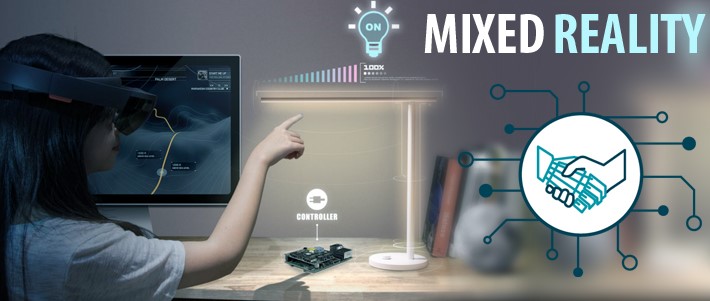In the evolving landscape of digital experiences, Mixed Reality (MR) stands as a revolutionary step forward, blending the lines between the physical and digital worlds. It’s a symphony of augmented reality (AR) and virtual reality (VR), combining the best of both to immerse users in a world where digital and physical elements interact seamlessly.
Understanding Mixed Reality
Unlike VR, which immerses users in a completely virtual environment, or AR, which overlays digital elements onto the real world, MR intertwines both, creating interactive environments where physical and digital objects co-exist and interact in real-time. Imagine having a holographic meeting with colleagues from across the globe, or a digital pet that can interact with your real-world living room furniture; that’s the promise of MR.
The Advent of Mixed Reality
The concept of MR isn’t entirely new. In fact, its budding presence was noticed as early as 2017. With advancements in technology and the miniaturization of computing resources, MR devices began to emerge, providing an interactive experience that hadn’t been seen before. Wearables, holographic displays, and specialized glasses offer a window into this mixed world, enabling interactions that seemed futuristic a mere decade ago.
Applications of Mixed Reality
The application of MR goes beyond gaming and entertainment, proving to be beneficial in a myriad of industries:
- Education: Mixed Reality provides an interactive learning environment where students can manipulate and engage with holographic objects, making abstract concepts tangible and easier to understand.
- Healthcare: Surgeons can overlay digital scans on the actual patient for precision-based procedures, and medical students can practice complex surgeries in a risk-free, mixed-reality environment.
- Real Estate: Potential buyers can take virtual tours of properties, customizing interiors with digital furniture to visualize their future home.
- Retail: Shoppers can try on outfits or accessories virtually, seeing how they look before making a purchase decision.
- Engineering and Design: Designers can manipulate and evaluate 3D prototypes in the real world, making design iterations more efficient.
The Potential and Challenges
While MR holds enormous potential, it’s not without challenges. Hardware limitations, software compatibility, and the development of truly immersive content are hurdles yet to be fully overcome. Moreover, as with any digital interface, there are concerns about privacy and the implications of blending digital content with real-world interactions.

Looking Ahead
The future of MR is brimming with possibilities. As technology continues to advance, the line between the virtual and real worlds will blur even further. Mixed Reality could redefine how we learn, work, and play, pushing the boundaries of our experiences.
In conclusion, Mixed Reality is not just another technological advancement; it represents a shift in how we perceive and interact with the world around us. The fusion of real and digital, tangible and virtual, is set to revolutionize industries and redefine experiences. While challenges remain, the potential of MR is boundless, promising a future where our interactions with technology become more natural and immersive than ever before.
